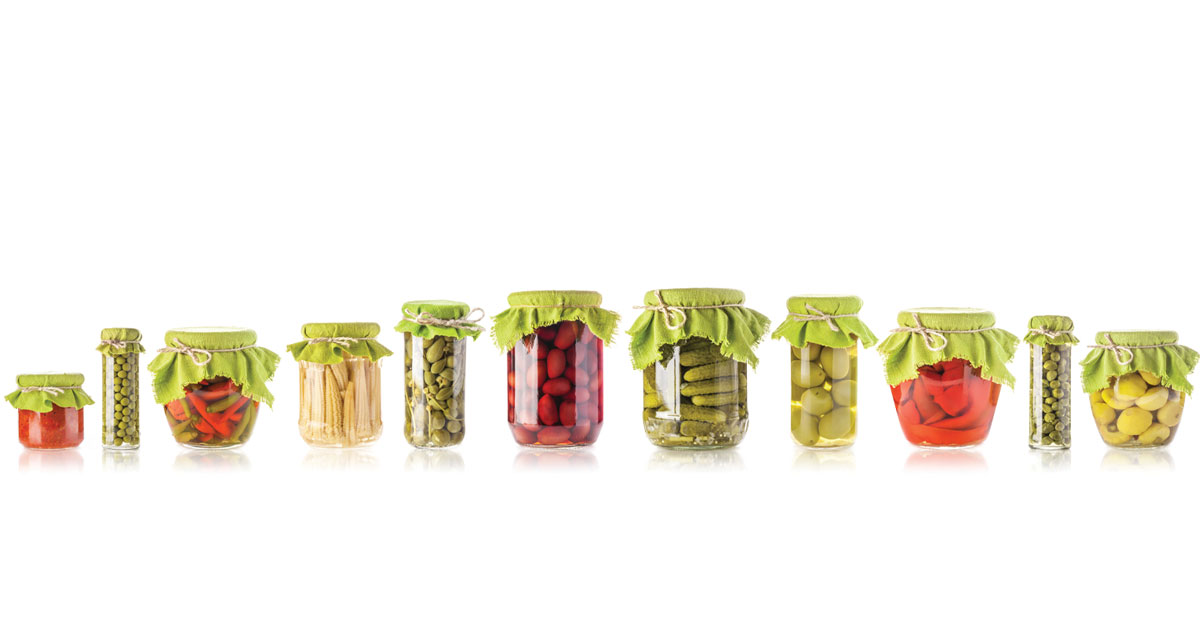Botulism is a severe but rare chemical poison that attacks the body’s nerves one or two days after consuming a contaminated food. The earliest symptoms appear in the eyes and face, resulting in blurred vision, drooping eyelids, and vomiting. A severe toxicity will impact the muscles, controlling respiratory systems, and may lead to unconsciousness. How does this happen? A spore, existing as dirt and dust, moves into a low-oxygen environment, such as an enclosed jar or can, and transitions into a dangerous toxin. The best way to prevent home-canned foods from contamination is to understand pH levels and practice habits of safety.
Why is pH Important?
The pH factor refers to the levels of hydrogen ion activity in a solution. The measurement range extends from 0, the most “acidic,” to 14, the least, termed “alkaline.”
- Low-acid foods require a pressure cooker and to be heated to 250 degrees Fahrenheit to kill bacteria. Researching proven and tested recipes will help ease you into this type of canning experience.
- Acidic foods with a pH level of 4.6 and below require a boiling water bath process to preserve foods effectively.
Most people believe acidity and pH levels are equal, which is not true! Some acidic foods, such as tomatoes and figs, have a level greater than 4.6. The solution is to add citric acid or lemon juice.
Canning Tomatoes
Prepare a pot of hot water while marking an “x” with a knife on the top of each tomato. Allow a handful of tomatoes to blanch for five seconds. The peels remove easily. Put in a clean, glass Mason jar, add two tablespoons of lemon juice, a teaspoon of salt, and wipe the rim before adding new seals and rings. Place the jars in water, fully covered by the water, for 45 minutes.
Canning Cucumbers
Use “pickling” cucumbers, which are smaller in size, providing small slices. Whether you choose dill, sweet and sour, or bread and butter, having a homemade jar of pickles makes a great gift or a quick addition to any food-based gathering! Start collecting seasonings, such as dill, red pepper flakes, garlic cloves, mustard seed, celery seed, and coriander, early. Canners will discover barren shelves if important ingredients, especially vinegar and pickling salt, are not purchased in advance!
A few points to keep in mind:
- As gardeners become overwhelmed by harvesting cucumbers daily, don’t leave your cucumbers soaking in refrigerated saltwater for too long. Take the time to process!
- Pack the jars, leaving one inch of air space at the top.
- Always wipe the rim clean and cover with a lid and rings.
- Cucumbers take five minutes in a water bath. Remember, the longer you boil, the softer the pickles become.
- After removing jars, listen for the audible popping sound on your jars. If you can press down on the lid, it’s not sealed!
Canning Beans
Calculations are necessary when canning. Roughly nine pounds of beans fills nine pints, and 14 pounds accommodates seven quarts.
Important tips:
- Begin by soaking the beans in cold water; then, trim the ends and pack tightly in a hot, sterilized glass jar, leaving an inch of air space.
- Stir and press lightly to release the bubbles.
- Add canning salt, a half-teaspoon for pints, one teaspoon for quarts to enhance flavoring.
- Wipe rims before sealing!.
- Pints of beans require 20 minutes in a pressure-canner, while quarts need 25 minutes.
Tip: Follow all canning tips when processing asparagus, green beans, peppers, beets, and corn. Each vegetable is a prime incubator for botulism. Check temperatures! If unsealed, one option is to refrigerate and eat the canned vegetable within a week. Should the canned jar go undetected beyond 24 hours, discard it immediately!
Canning Corn
Approximately 30-pounds of corn fills seven quarts.
Begin with blanching the cob for two minutes, then transfer to a bath of ice water. Cut the corn away from the cob and pack in hot, sterilized jars. Add a half-teaspoon of salt to each pint, or one teaspoon per quart. Fill with boiling water with one inch of air space. Stir! Wipe the rim before sealing! In a pressure canner, allow 1 hour and 25 minutes for quarts and 55 minutes for pints.
Tip: Consider adding jalapenos or other spices to a few jars, or squash, garlic cloves, or green peppers!
Using Pickling Salt
Often labeled as “canning” or “pickling salt,” it is fine-grained and iodine-free. Without the additives, it’s simply a raw mineral used to prevent canned vegetables from turning colors. Cloudy brine is an additional way to detect spoilage!
This summer, can with confidence!























